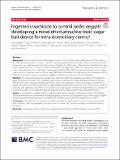Files in this item
Ingested insecticide to control Aedes aegypti : developing a novel dried attractive toxic sugar bait device for intra-domiciliary control
Item metadata
| dc.contributor.author | Sippy, Rachel | |
| dc.contributor.author | Rivera, Galo E | |
| dc.contributor.author | Sanchez, Valeria | |
| dc.contributor.author | Heras, Froilán | |
| dc.contributor.author | Morejón, Bianca | |
| dc.contributor.author | Beltrán, Efraín | |
| dc.contributor.author | Hikida, Robert S | |
| dc.contributor.author | López-Latorre, María A | |
| dc.contributor.author | Aguirre, Alex | |
| dc.contributor.author | Stewart-Ibarra, Anna M | |
| dc.contributor.author | Larsen, David A | |
| dc.contributor.author | Neira, Marco | |
| dc.date.accessioned | 2022-01-19T17:30:47Z | |
| dc.date.available | 2022-01-19T17:30:47Z | |
| dc.date.issued | 2020-02-17 | |
| dc.identifier | 277524196 | |
| dc.identifier | 51318c21-b8df-4c61-87c5-95e80b15adee | |
| dc.identifier | 32066486 | |
| dc.identifier | 85079613867 | |
| dc.identifier.citation | Sippy , R , Rivera , G E , Sanchez , V , Heras , F , Morejón , B , Beltrán , E , Hikida , R S , López-Latorre , M A , Aguirre , A , Stewart-Ibarra , A M , Larsen , D A & Neira , M 2020 , ' Ingested insecticide to control Aedes aegypti : developing a novel dried attractive toxic sugar bait device for intra-domiciliary control ' , Parasites and Vectors , vol. 13 , 78 . https://doi.org/10.1186/s13071-020-3930-9 | en |
| dc.identifier.issn | 1756-3305 | |
| dc.identifier.other | PubMedCentral: PMC7027216 | |
| dc.identifier.other | ORCID: /0000-0003-3617-2093/work/106838519 | |
| dc.identifier.uri | https://hdl.handle.net/10023/24713 | |
| dc.description | Laboratory work was Funded by Pontificia Universidad Católica del Ecuadorʼs Internal Research Grant L13234, awarded to MN. Semi-field work was funded by a seed grant from the Syracuse University, awarded to DL. | en |
| dc.description.abstract | Background: Illnesses transmitted by Aedes aegypti (Linnaeus, 1762) such as dengue, chikungunya and Zika comprise a considerable global burden; mosquito control is the primary public health tool to reduce disease transmission. Current interventions are inadequate and insecticide resistance threatens the effectiveness of these options. Dried attractive bait stations (DABS) are a novel mechanism to deliver insecticide to Ae. aegypti. The DABS are a high-contrast 28 inch2 surface coated with dried sugar-boric acid solution. Aedes aegypti are attracted to DABS by visual cues only, and the dried sugar solution elicits an ingestion response from Ae. aegypti landing on the surface. The study presents the development of the DABS and tests of their impact on Ae. aegypti mortality in the laboratory and a series of semi-field trials. Methods: We conducted multiple series of laboratory and semi-field trials to assess the survivability of Ae. aegypti mosquitoes exposed to the DABS. In the laboratory experiments, we assessed the lethality, the killing mechanism, and the shelf life of the device through controlled experiments. In the semi-field trials, we released laboratory-reared female Ae. aegypti into experimental houses typical of peri-urban tropical communities in South America in three trial series with six replicates each. Laboratory experiments were conducted in Quito, Ecuador, and semi-field experiments were conducted in Machala, Ecuador, an area with abundant wild populations of Ae. aegypti and endemic arboviral transmission. Results: In the laboratory, complete lethality was observed after 48 hours regardless of physiological status of the mosquito. The killing mechanism was determined to be through ingestion, as the boric acid disrupted the gut of the mosquito. In experimental houses, total mosquito mortality was greater in the treatment house for all series of experiments (P < 0.0001). Conclusions: The DABS devices were effective at killing female Ae. aegypti under a variety of laboratory and semi-field conditions. DABS are a promising intervention for interdomiciliary control of Ae. aegypti and arboviral disease prevention. | |
| dc.format.extent | 11 | |
| dc.format.extent | 1696320 | |
| dc.language.iso | eng | |
| dc.relation.ispartof | Parasites and Vectors | en |
| dc.subject | Aedes | en |
| dc.subject | Animals | en |
| dc.subject | Eating | en |
| dc.subject | Ecuador | en |
| dc.subject | Female | en |
| dc.subject | Insecticides | en |
| dc.subject | Male | en |
| dc.subject | Mosquito Control/methods | en |
| dc.subject | Mosquito Vectors | en |
| dc.subject | Sugars/chemistry | en |
| dc.subject | QR Microbiology | en |
| dc.subject | RA0421 Public health. Hygiene. Preventive Medicine | en |
| dc.subject | NDAS | en |
| dc.subject | SDG 3 - Good Health and Well-being | en |
| dc.subject.lcc | QR | en |
| dc.subject.lcc | RA0421 | en |
| dc.title | Ingested insecticide to control Aedes aegypti : developing a novel dried attractive toxic sugar bait device for intra-domiciliary control | en |
| dc.type | Journal article | en |
| dc.contributor.institution | University of St Andrews. Statistics | en |
| dc.identifier.doi | https://doi.org/10.1186/s13071-020-3930-9 | |
| dc.description.status | Peer reviewed | en |
This item appears in the following Collection(s)
Items in the St Andrews Research Repository are protected by copyright, with all rights reserved, unless otherwise indicated.

